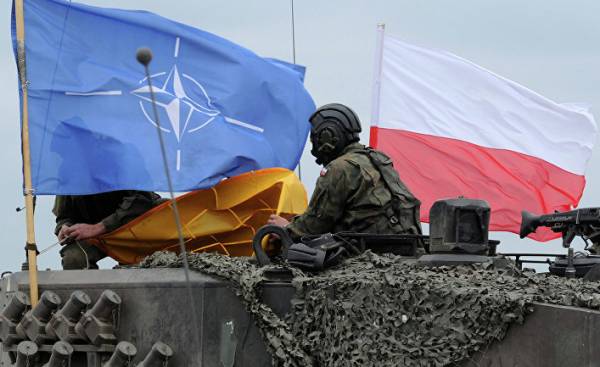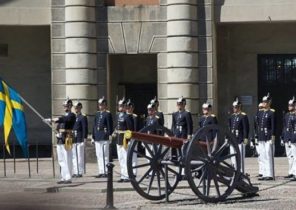
Interview with historian and Sovietologist Marek Keratom.
Polonia Christiana: How did the Soviet-Polish relations after the signing of the Treaty of Riga in 1921?
Marek Konrat (Marek Kornat): formally, the Treaty of Riga ended the Polish-Soviet war. He established peace between the two warring parties, but did not end the Polish-Soviet rivalry. The Soviet side believed that the peace with Poland interim political agreement, which sooner or later will be broken. She never reconciled with the existence of an independent Polish state.
It should be recalled that reaching an advantageous agreement with Germany at Rapallo, which strikes at the Versailles order Soviet Russia lost interest in agreements with the poles. The German leadership insisted that it did not conclude with Warsaw, no new international treaties, fixing territorial status quo, that is the Eastern border of Poland. In the second half of 1920-ies the Soviet Union and Germany engaged in secret military talks, which were very dangerous concept reductions of Polish territory up to the ethnographic borders…
Already in the 1920s?!
— So. Fortunately for us, no agreement on this subject at the moment appeared. Both parties were just too weak to carry out such a plan. But the idea appeared and continued existence…
— What was the reason of so strong hostility of Moscow to Warsaw?
— There are several factors. First, Russia had a great ideological ambitions: she wanted to carry communism abroad, and Poland is on the way to Germany. Secondly, Moscow was convinced that Warsaw seeks to create a bloc of States hostile to her in Eastern Europe. Of course, the Polish diplomacy was not so strong, but that is another question. Third, the Soviets were afraid that józef piłsudski (Józef Piłsudski), who regained power after the coup of 1926, did not abandon the idea of restoring Poland in its reliance on Federal ties with Ukraine and other peoples of the former Polish-Lithuanian Commonwealth.
The Polish side did not trust Moscow, but this does not mean that our diplomats refused from any action aimed at stabilizing and normalizing relations with its Eastern neighbor. Such steps were undertaken, starting in 1925.
— What were the efforts of the Polish diplomacy?
The autumn of 1925 was marked by an unexpected and unpleasant from the point of view of Moscow turn in the international situation: the marked term of the agreement on the borders between Germany and France with the participation of great Britain and Italy acting as guarantors of these agreements. As a result, 16 October in Locarno was signed by the Rhine Pact.
From Moscow, this step of Germany looked a manifestation of disloyalty, it was contrary to the spirit of the policy of Rapallo, which began in 1922. The Soviet Union feared that Rafalska the system simply fades into the past. In this regard, in relations between Moscow and Warsaw for a while there has been a thaw. The Soviet Union wanted to show the Germans that he has prospects to establish contacts with Poland, if they decide to turn away from Moscow.
As a result, in September 1925, Warsaw unexpectedly visited the people’s Commissar for foreign Affairs Georgy Chicherin. He agreed with the Polish Minister of foreign Affairs Alexander Skrinsky (Aleksander Skrzyński) that the two countries will begin formal talks on concluding a non-aggression Pact. This is a very important moment in relations between the two States, which lasted seven years, the negotiations on this subject began then. Them several times suspended and then resumed, and the crown was signed on 25 July 1932.
— However, before the signing of the Soviet-Polish non-aggression Pact appeared two papers, the first was a Pact of Briand-Kellogg.
— It was a multilateral Treaty. He was joined by all the civilized Nations of the world, which was at that time about 60. He appeared so in April 1927, the tenth anniversary of the US entry into the First world war, the foreign Minister of France Aristide Briand (Aristide Briand) publicly appealed to the American leadership. He asked whether the U.S. is ready once again to support France, if the world will again face such a threat, which created Germany during the First world war?
Since the USA after coming to the presidency in the beginning of 1921 President Woodrow Wilson maintained a policy of isolationism, and therefore refused the obligations contained in the Covenant of the League of Nations and ratify the Treaty of Versailles, a straight answer to give, they could not. In turn to leave a question without an answer, meant to drop your prestige. In the end, Washington responded through its Secretary of state Frank Kellogg (Frank Kellogg) (who later became a Nobel peace prize laureate) that the United States cannot conclude a Union and to guarantee France’s security, but is willing to support a broader concept of the renunciation of war as an instrument of foreign policy.
To participate in the initiative invited all States. Began consultations and then formal negotiations, which ended on 27 August 1928 by the Treaty the renunciation of war. Originally it was signed by such world powers as the USA, France, UK, Italy and Japan. The agreement allowed to join Germany and the Soviet Union and the two States with the status of world powers, but played an important role because of its geopolitical position — Poland and Czechoslovakia. The rest of the country won the right to join the Pact later, which is what happened.
— What assessment can You give of this Covenant?
— Briand Pact-Kellogg was an agreement that gave an illusory hope for peace. He condemned the war but did not set any measures not determined how to act in case of violation of its provisions. It was a moral Declaration, which had no real value. The only important aspect of this Pact was that it formulated the concept of “crime against peace”. Later it helped to condemn in Nuremberg such as the German war criminals, such as Ribbentrop.
The Pact of Briand-Kellogg very soon began to break. It was first done by Japan, which in 1931 was a blow to China. Then Italy, in 1935, attacked Abyssinia, then — Germany and the Soviet Union, who are 1 and 17 September 1939 invaded Poland. I repeat: this agreement had no real value. It was only the generous promise, relying on high-sounding words.
— Can we say the same thing about the Litvinov Protocol, signed on 9 February 1929?
— Yes, by itself it had no special weight. It should, however, draw attention to two of his political aspect. First, in the late 1920-ies the Soviet propaganda, trying to win the favor of the international community, began to use peaceful slogans. Promoting the idea of “the Soviet Union — the state of peace-loving people”, the Bolsheviks decided to use the Pact of Briand-Kellogg to make the neighbors a “special offer”. They were asked to sign an additional agreement with the Soviet government not to wait for the ratification of the Covenant, and to enter its provisions into effect. The Litvinov Protocol only repeated the theses signed in Paris the agreement.
Secondly, the Soviet proposal for Warsaw looked interesting because it got all the European neighbors of the USSR. The poles understood that it will not have a special impact contacts with Moscow, but agreed to the contract, because it creates a sense that all neighbors of the Soviet Union work together and unanimously enter into a agreement that will consolidate the borders in Eastern Europe.
The foreign press (particularly German and French) declared that the Litvinov Protocol is a de facto nonaggression Pact, although with this kind of international agreement a General he was little. I must also add that the honour to speak on behalf of all European neighbors had Polish Ambassador Stanislaw Pateco (Stanisław Patek). It was an important gesture not so much in political but in terms of propaganda.
The poles realized that this is another Soviet hoax?
— Of course. You can bring this illustration: during a meeting of Jozef Pilsudski with the Deputy Minister of foreign Affairs Alfred Vysotsky (Alfred Wysocki) on the subject of this agreement, the Marshal rose from his chair and pointed to a certain part of the body, saying that the agreement for him to one place.
Once Pilsudski eloquently stated what he thought about the agreement with the USSR, and in Europe believed that the Litvinov Protocol is the non-aggression Pact, why in 1932 needed to sign another document?
The Litvinov Protocol was a multilateral Treaty, and Marshal Pilsudski believed more effective bilateral agreements. He was a supporter of bilateralism, believing that relations between States are particularly effective are those contracts in which mutual assurances we give each other are only two sides. Two sovereign States are easier to negotiate than, for example, five, as in the second case, there can be differences in the interpretation of the signed text.
Following this concept, the Polish diplomacy, led by Minister of foreign Affairs August Zalesky (August Zaleski) (the most important decisions remained thus for Pilsudski), was of the opinion that the USSR should sign a bilateral non-aggression Pact. The Polish leader, apparently, wanted a way to show Germany that Poland has room to maneuver because it is able to overcome differences with Russia.
In 1930 there are new opportunities. The political system of the Weimar Republic in crisis, which led to the destabilization of the country. The future of German-Soviet relations, based on “the concept of Rapallo”, was called into question. An even greater threat to the Soviet side was the Japanese invasion of Chinese Manchuria in October 1931. The Kremlin was thinking, is this the first step to attack the Soviet Union. In fact, these plans the Japanese were not, but Stalin and his men were afraid. However, Polish diplomacy could not know about it.
Let me remind you that Russia for many centuries has adhered to the principle that to fight on two fronts impossible. Following this idea, Stalin ordered Litvinov to the Commissioner as soon as possible to complete after seven years of negotiations with Poland. He wanted at all costs to ensure peace in Europe in the event of which seemed to him the real prospect of war with Japan.
I believe that Soviet dictator more scared it was a clash with the Japanese, and not the destabilization of Germany. Some historians also point to other circumstances. 1929-1930 years is the beginning of universal collectivization of the village in the USSR. Perhaps, Stalin wanted to ensure peace for the duration of this “reform.” In my opinion, a special role in Polish-Soviet negotiations is not played.
I should add that the Polish government was pleased with Moscow’s willingness to make concessions, it was a good time, as relations between Warsaw and Berlin at the moment escalated. Germany, beginning in 1930, put forward the increasingly insistent demands on the movement of the boundary with Poland. So the poles after very complex negotiations failed in the end, to overcome the last disagreements with the Soviet Union.
— What were those differences?
— The main point of contention was the demand of the Polish diplomacy that the Soviet Union also signed a non-aggression Pact with Romania. At the very last stage, the poles refused. By the way, Romanian politician Titulescu (Nicolae Titulescu) showed a hostile attitude to Poland, and in Warsaw suspected that he wants to prevent the creation of a Polish-Soviet Alliance.
Another controversial issue may seem from today’s point of view is very strange. International law at the time declared that the Pact needs to be fixed right the League of Nations to intervene through the arbitration proceedings. Simply put: we sign the contract, and if in the future someone will do it, the League will be able to give his assessment of the situation. Moscow on such a condition did not agree, saying that the League of Nations is anti-Soviet organization of the capitalist countries (the USSR attitude to it has changed only in 1934). The final phase of the negotiations the Polish government, seeking as quickly as possible to sign the Treaty, refused formula, providing for the right League.
— In today’s international politics, the concept of “non-aggression Pact”?
In post decade, such agreements have been very common form of security guarantees. To conclude they sought, of course, warring with each other state. Most often neighbors with a common border, but not only: for example, in 1932, a Treaty signed by the USSR and Italy, which separates a long distance. The States that have signed the non-aggression Pact, promised to renounce the use of force against the second side and gave guarantees of territorial integrity. An unusual example of this type of document, the name of which there is no direct reference to the content, was the guarantee Pact signed at Locarno.
International law, its norms, formats guarantees evolyutsioniruet, therefore now almost no one enters into such contracts. Recently, the proposal to sign such a document had been received only from North Korea to the US (but not against South Korea). In any case, Washington continues to reject it.
— Thank you for the interview.







